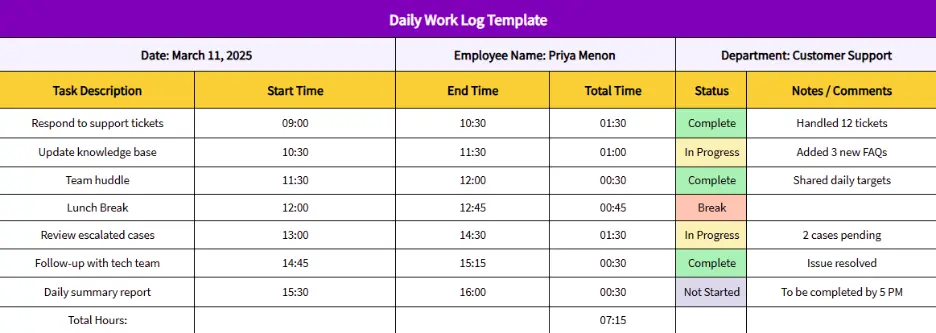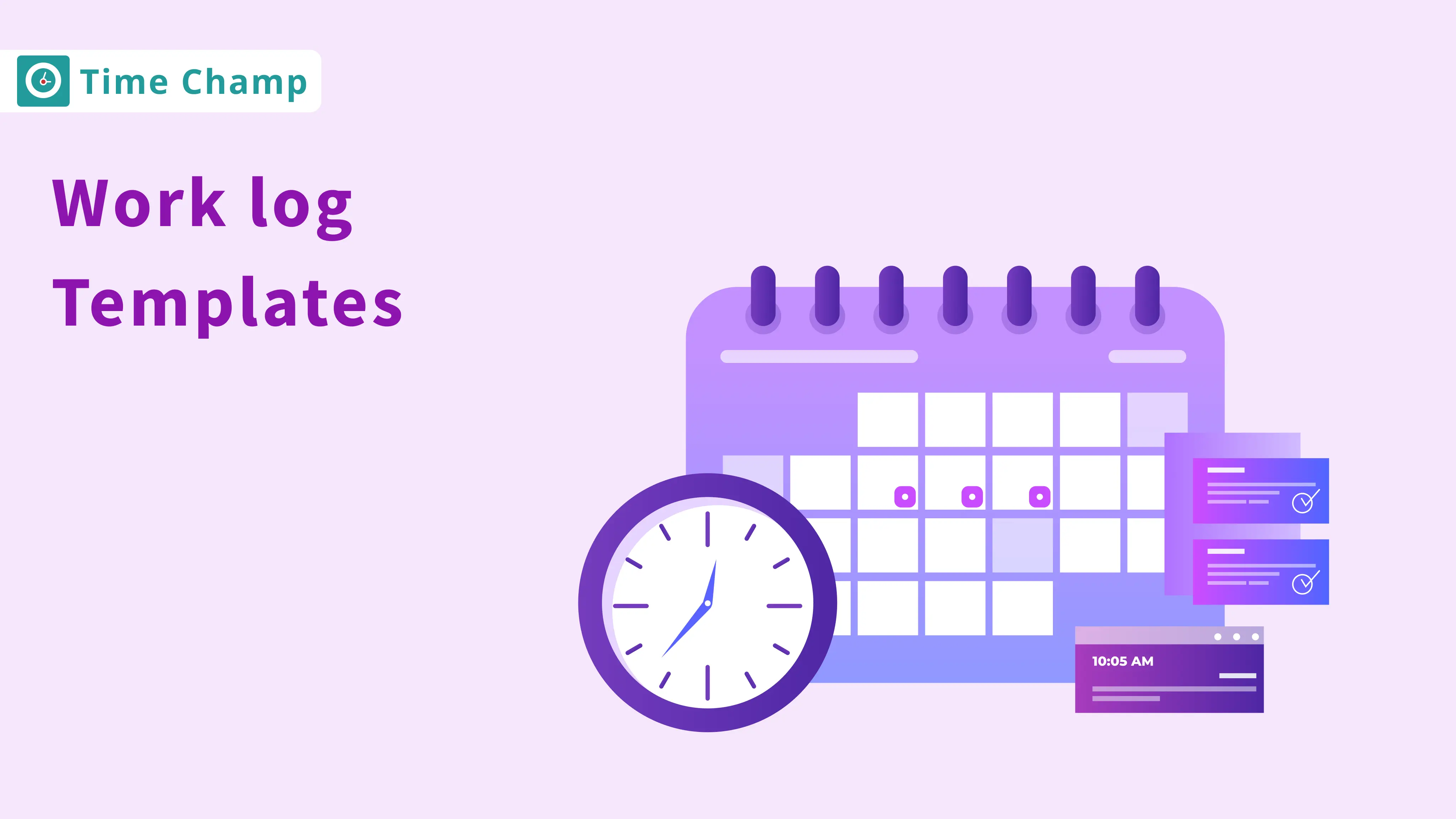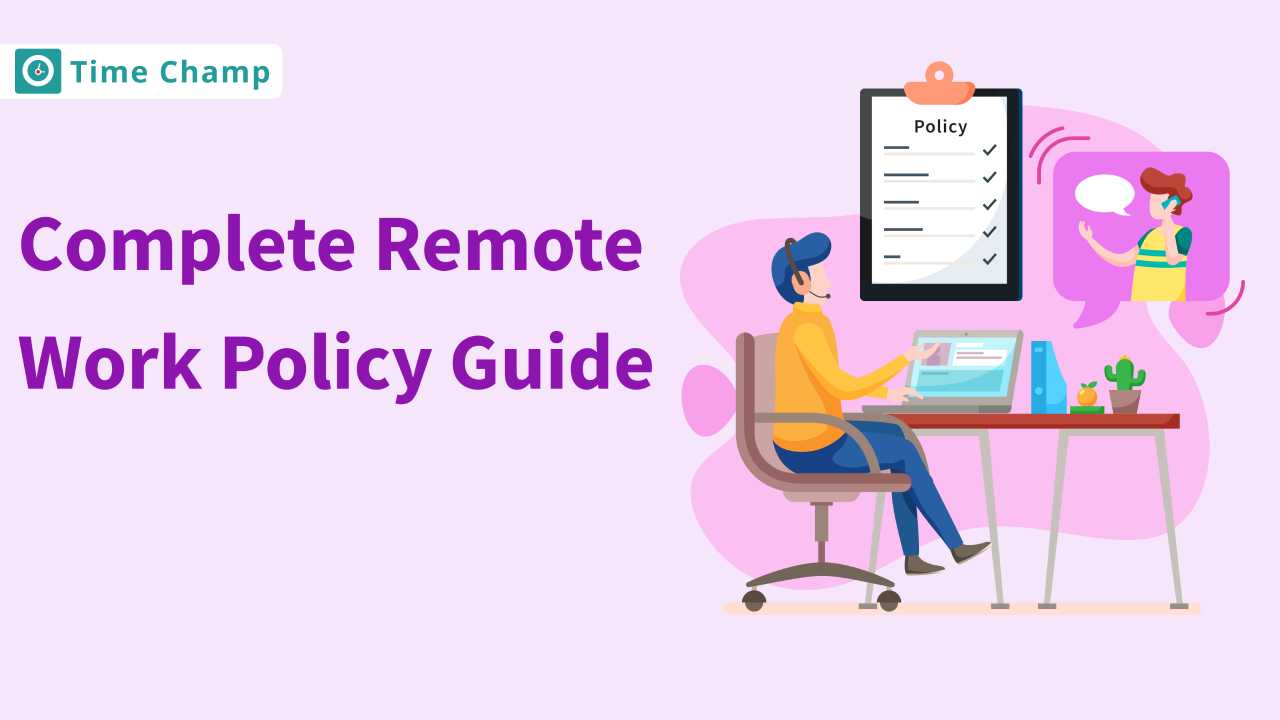Work log templates are absolutely efficient if you want every process to be organised and in place, because it doesn’t take a lot of time to create a mess, and clearing takes time and effort. These templates give you an instant glance into your employee’s work whenever needed.
If you are searching for some practical and free work log templates, I’ve got you.
In this blog, I have shared 7 different types of downloadable and printable work log reports to simplify your operations. Follow along to find out.
1. Employee-Focused Work Logs
A. Employee Work Log Template
This template gives you a detailed view of your employee’s work, when they started, end time, and how long they have been working on each task.
This employee work log template is created to capture your employee’s entire workday in the most structured format. It also usually contains data such as start and end time, total hours worked, the total hours spent at work and specific tasks handled during that time. This template gives you a quick overview of your team's work, helping you to easily track productivity and identify time gaps. It maintains a high level of transparency, which makes performance tracking and workload balance simple and clear.

Key Features:
- Task Tracking: Keeps track of all the tasks performed in a day, and assists you in understanding how time is being utilised.
- Start & End Times: Records start and finish times of every task, which provides a better understanding of the workflow throughout the day.
- Status Updates: Tracks the current status of tasks, providing insight into what is completed, pending, or in progress.
- Notes Section: This template comes with a comments or explanations space, which precisely captures context, observation, and other details for reporting.
Best For:
Employees who want to keep a clear account of daily activities, managers who want visibility into individual employee productivity, and HR managers who are preparing evaluations.
B. Hourly Work Log Template
You can use this template to log every hour’s progress for more detailed reporting. When you want to know everything that happened during a certain period of time, these templates are the best, they inform you what is lacking and where.
Here, each entry tells everything you need, what tasks were handled, how long it took and who worked on it.
It gives you visibility, the visibility that helps make better decisions, the visibility that makes reporting genuinely useful.

Key Features:
- Hourly Breakdown: Records the activities on an hourly basis, including workflow and productivity trends.
- Interruptions & Breaks: Captures Interruptions and breaks to identify the workflow disruptions or any chances for better scheduling.
- Task Duration Analysis: Captures how long each task took to complete, which can help in realistic task planning and resource allocation.
- Quick Overview: Provides a summary of the performance of each hour, which helps to identify trends and optimise time in the most efficient way.
Best For:
Employees with time-sensitive jobs, managers handling detailed projects and freelancers or consultants billing clients per hour.
2. Time-Based Work Logs
These are the work logs that are based on time, daily, weekly and monthly. You can find all three here, scroll to reach.
A. Daily Work Log Template
As the name suggests, you can use this template to log daily work activities. You can also add start and end times of each task and update the status column as needed.
If you want to add more sections, like breaks and comments, feel free to edit accordingly, because capturing small details like brief breaks or minor follow-ups is important, it can dramatically improve understanding of how work actually happens.

Key Features:
- Complete Daily Snapshot: Captures all tasks within a day, providing a comprehensive overview of completed and ongoing activities.
- Start/End Times: Records when tasks begin and finish, helping monitor efficiency and the flow of daily work.
- Status Column: Tracks the progress of each task, reflecting completion, pending items, or tasks requiring follow-up.
- Notes Section: Creates space for additional observations or reflections, capturing challenges and key details for reference.
Best For:
Individuals wanting daily productivity insights, managers reviewing day-to-day performance, and teams handling quick tasks.
B. Weekly Work Log Template
Use this template to fill in all those weekly tasks, and here you can even add a date as well. You can just inform your employees to fill in their names along with the department and update the logs as they tick off each task.
Need more columns? You are the editor now, feel free to modify as needed.

Key Features:
- Weekly Summary: Records all weekly tasks, capturing recurring patterns, delays, or trends for better planning.
- Priority Tracking: Tracks high-priority tasks and their completion, highlighting focus areas for the team or individual.
- Challenges Section: Captures obstacles encountered during the week, offering insights for adjustments or improvements.
- Progress Insights Tracks the overall performance during the week, assists in revealing inefficiency areas and possible workflow optimisations.
Best For:
Project managers who track the weekly progress, teams that coordinate across different departments and individuals who analyse weekly productivity trends.
C. Monthly Work Log Template
This is a brief one, where you can find a whole month’s work logs in one place and that too at a glance.
Whenever you just want to know the number of tasks each employee completed for a monthly performance review, you can use this without a second thought.
You can even measure your employee’s productivity using these reports, and yeah, you can also ensure deadlines are met on time with this pace of task completions.

Key Features:
- Long-Term Overview: Captures tasks and achievements across a month, creating a clear view of performance trends
- Task Aggregation: Combines daily and weekly entries into a consolidated record, capturing patterns and recurring activities.
- Resource Tracking: Logs who worked on each task, which you can use to know the work distribution and team utilisation.
- Planning Aid: Captures insights from the month, helping guide task allocation, goal setting, and future planning.
Best For:
Department heads, project leads, and professionals needing long-term insights for planning, evaluation, or client reporting.
3. Project/Task-Based Work Logs
Well, these reports are based on project and task completion, they tell you at what pace your projects are moving and where you can make improvements.
A. Work Activity Log Template
This template assists you in streamlining sprint discussions by giving you a structured area to establish goals, define priorities, and allocate tasks efficiently. It makes sure you and your team are aware of what to deliver and how it relates to sprint goals. This template will help you manage your time, maintain a clear communication channel, and identify possible challenges in advance so that your sprint begins with a solid foundation and remains on schedule.

Key Features:
- Task/Subtask Tracking: Records all project tasks and subtasks, capturing step-by-step progress for detailed understanding.
- Time Tracking: Logs the time spent on each task, capturing duration and providing insight into efficiency levels.
- Progress Updates: Captures task completion and progress details, helping visualise workflow and pending activities.
- Contextual Notes: Records comments, dependencies, and additional observations, creating a richer understanding of project dynamics.
Best For:
Project managers who monitor various activities, teams that collaboratively work on more detailed projects, and employees who report complex workflows.
B. Project Work Log Template
If you ever wanted to just look at a project log, here it is, a simple and self-explanatory log that covers when the project started, when it ended, how long it took to complete it, who all worked on it, and finally who’s responsible for the entire project.
You can make tweaks to this template and mould it to your company’s requirements.

Key Features:
- Project Overview: Captures all project tasks, milestones, and ownership, providing a complete picture of the project.
- Deadline Monitoring: Records deadlines and due dates, capturing potential risks and helping avoid project delays.
- Risk Visibility: Tracks tasks with potential issues or bottlenecks, capturing where extra attention or resources may be required.
- Resource Allocation: Captures how team effort and resources are distributed across tasks, providing insights for effective planning.
Best For:
Project heads dealing with long-term projects, cross-functional teams working on client deliverables, and other stakeholders who need clear reports on project progress and how resources are being used.
What Are the Pros and Cons of a Work Log Template?
Work log templates have both pros and cons, I will list both so that you can decide better.
| Pros | Cons |
|---|---|
| 1. Keeps work in a structured way | 1. Becomes overly time-consuming if too much detail is recorded |
| 2. Enhances employee accountability | 2. Logs can sometimes turn into a routine without providing real insights |
| 3. Makes identification of work patterns and bottlenecks easier | 3. Manual logs often lead to inaccuracy |
| 4. Helps in making informed decision-making | 4. May seem restrictive for some employees |
| 5. Supports self-reflection and improvement among employees | 5. Can overemphasise quantitative over qualitative work |
How Can Time Champ Optimise Work Logs
If you are trying to step into work logs to organise your processes and keep a track of tasks and projects, Time Champ helps you do it more easily. Time Champ gives you the flexibility to maintain both manual and automatic work logs.
Let me tell you how it works
- Start the timer when working
- Review work logs
- Add missed work logs manually when the tracker was off
- Submit
- Manage
It’s that simple to create and manage work logs with Time Champ, and let me tell you the best part, it gives you insights, I mean real insights that help you allocate tasks better, plan projects efficiently, and ensure peak productivity.
Conclusion
Work log templates for sure help you make things more organised, but choosing the right one and having clarity on what to track makes it even better. So, pick what seems right for you and start organising your workflows for the better. Also, if you want to turn raw data into insights, just pair these templates with consistency and periodic reviews to see the real impact.
Remember, these are the small records that one day turn into a powerful system that helps you make the right decisions to improve the overall efficiency of your workforce.
Frequently Asked Questions
Absolutely, each template shared can be easily customised in Excel, Word, or PDF. You can add columns, change headers, or include additional sections like comments, priority levels, or approval status, depending on how your team operates.
A work log is more detailed than a timesheet, it records specific tasks, progress updates, and comments, while a timesheet mainly tracks working hours. Work logs give qualitative insights into what employees actually do during those hours, not just how long they work.
Yes, you can, many managers out there often rely on work logs to evaluate consistency, productivity, and task ownership during appraisals. Logs give a factual basis for assessing performance rather than depending only on memory or subjective feedback.
You can communicate how work logs benefit them, like fair recognition, easier reviews, and balanced workloads. Keep the templates simple, avoid over-detailing, and integrate them into daily routines so it doesn’t feel like an additional task.
Ideally, work logs should be updated daily or in real-time as tasks are completed. Do not wait until the end of the week, as it often leads to missing small but important details. So make sure your employees log their work as soon as they complete a task and head to the next.






